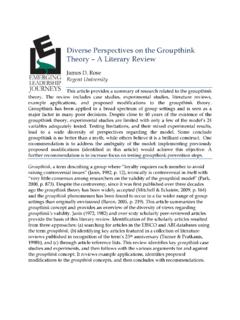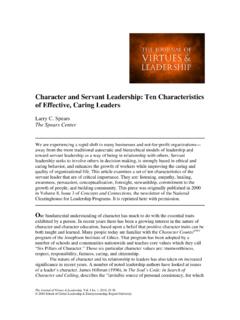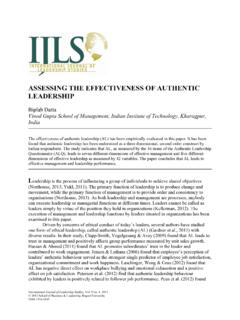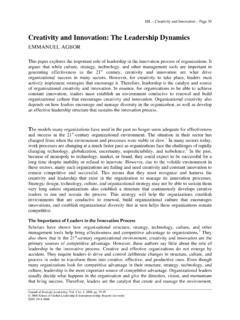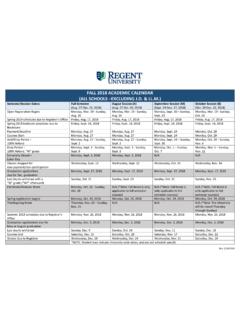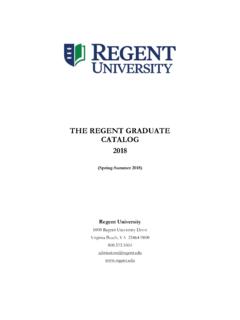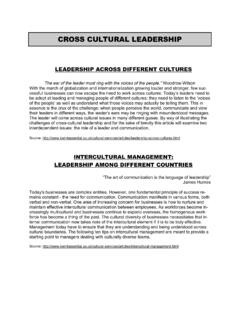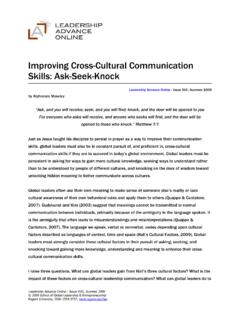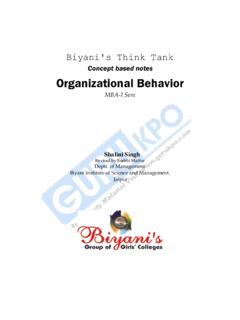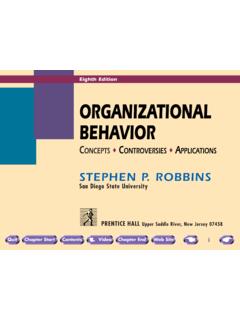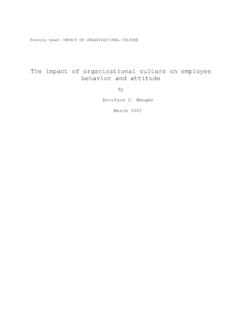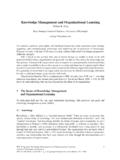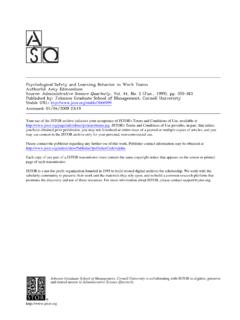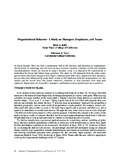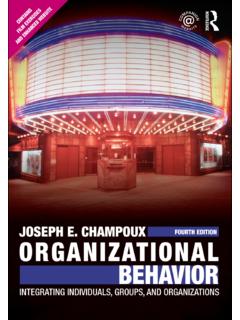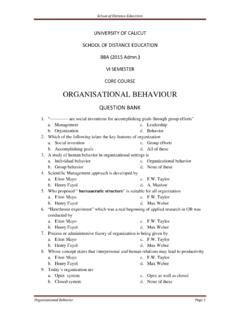Transcription of Leadership Behavior and Organizational Climate: An ...
1 Emerging Leadership Journeys, Vol. 5 Iss. 1, pp. 9- 35. 2012 regent university School of Global Leadership & Entrepreneurship ISSN 1941-4684 | Leadership Behavior and Organizational Climate: An Empirical Study in a Non-profit Organization Joseph B. Holloway regent university The primary purpose of this research paper is to present an empirical study framed by the theory that task-oriented and relations-oriented Leadership behaviors are positively related to the employees perceptions of Organizational climate. The study examined the following research question: Are task-oriented and relations-oriented Leadership behaviors related to different dimensions of Organizational climate in a non-profit organization?
2 The study introduces the theoretical perspective and examines the relevant literature that supports the significance of Leadership Behavior and Organizational climate. The methodology for collecting the data was through the combination of two quantitative instruments into a web-based questionnaire consisting of 79 questions aimed at determining the relative contribution that the independent variables (task-oriented and relations-oriented Leadership behaviors) have on the dependent variables (the different dimensions of Organizational climate). The following control variables were collected from the sample and were statistically controlled in the data analysis: age, educational level, gender, job rank, and job tenure.
3 The results of the study show that certain Leadership behaviors do have an impact on a few dimensions of Organizational climate. on-profit organizations have a more central role in society s response to social problems than ever before (Smith, 2002). Many non-profit organizations are small, ill equipped, and undercapitalized to respond to the growing demands of public funders for accountability. Non-profit organizations around the world are functioning in an increasingly competitive and complex world as they fiercely compete for funding sources, qualified staff, and clients (Jaskyte & Kisieliene, 2006; Trautmann, Maher, & Motley, 2007).
4 This shortfall of available resources has increased the reliance that non-profit organizations have on corporate sponsorship, which has impacted the governance of their organizations (Gray & Bishop Kendzia, 2009). Drucker (1990) believed that one of the basic differences in non-profit organizations and for-profit organizations is that non-profit organizations have many more constituencies to deal with than for-profit organizations. Leaders of non-profit organizations have never had the luxury of planning in terms of one constituency. Leaders of non-profit N Leadership Behavior and Organizational Climate P a g e | 10 Emerging Leadership Journeys, Vol.
5 5 Iss. 1, pp. 9- 35. 2012 regent university School of Global Leadership & Entrepreneurship ISSN 1941-4684 | organizations are responsible for their staff, customers, Board of Directors, multiple funding sources, and to their own particular clients and projects (Brinkerhoff & Brinkerhoff, 2002; Malloy & Agarwal, 2010). Even though planning for multiple constituencies may lead to differences in Leadership Behavior (Phipps & Burbach, 2010), Drucker (1990) reported that the toughest, most important task that non-profit leaders face is getting the different groups of constituencies to agree on the long-term goals of the organization.
6 This task alone can create differences in how leaders of non-profit organizations behave. Without positive daily interactions with their employees, or the human side of their work, the other aspects of a leader s responsibilities will suffer (Cangemi, Burga, Lazarus, Miller, & Fitzgerald, 2008). Leadership is a two-sided engagement between leaders and employees to achieve a common goal (Antelo, Henderson, & St. Clair, 2010; Eagly, 2005; Northouse, 2010). This engagement actuates leaders to influence their employees Behavior while simultaneously influencing their employees perceptions. This leads to expectations of appropriate conduct that becomes ingrained in the Organizational climate (Grojean, Resick, Dickson, & Smith, 2004).
7 In many cases, effective leaders possess both a concern for the task while establishing an individual relationship with their employees. Since there is a relative direct connection between employees, their productivity, and the organization s performance (Wang & Shyu, 2008), it is essential for leaders to maintain a positive work environment to maximize and enhance their employees efforts to reach Organizational efficacy. Kouzes and Posner (2010) found that a leader s Behavior explains nearly 25 percent of the reason that people feel productive, motivated, energized, effective, and committed in their workplaces. As a result, the specific research question that addresses the theory in this paper is: Research Question 1: Are task-oriented and relations-oriented Leadership behaviors related to different dimensions of Organizational climate in a non-profit organization?
8 The primary purpose of this empirical study is framed by the theory that task-oriented and relations-oriented Leadership behaviors are positively related to the employees perception of Organizational climate. This study introduces the theoretical perspective and examines the relevant literature that supports the significance of Leadership Behavior and Organizational climate. The methodology for conducting the study was the use of two quantitative instruments aimed at determining the relative contribution that the independent variables (task-oriented or relations-oriented Leadership behaviors) have on the dependent variables (the different dimensions of Organizational climate).
9 Leadership Behavior and Organizational Climate P a g e | 11 Emerging Leadership Journeys, Vol. 5 Iss. 1, pp. 9- 35. 2012 regent university School of Global Leadership & Entrepreneurship ISSN 1941-4684 | Theoretical Perspective The central importance of the study lies in the concept that employees are potentially the highest value within organizations (Chien, 2004). Although the research domains of Leadership and Organizational climate are implicitly entwined (Kozlowski & Doherty, 1989), there has been little theoretical development or empirical research that addresses the impact that task-oriented or relations-oriented Leadership behaviors have on Organizational climates in non-profit organizations.
10 Hui, Chiu, Yu, Cheng, and Tse (2007) found that some authors conceptualize Leadership Behavior as a precursor to Organizational climate ( Dickson, Smith, Grojean, & Ehrhart, 2001; Koene, Vogelaar, & Soeters, 2002; Litwin & Stringer, 1968). Momeni (2009) found that more than 70% of employees perceptions of Organizational climate are shaped directly by their leader s style of Leadership and Behavior . Kozlowksi & Doherty (1989) noted that early theorists ( Blake & Mouton, 1964; Indik, 1968; Lewin, 1951; Likert, 1967; Litwin & Stringer, 1968; McGregor, 1960) regarded Leadership as an important Organizational factor that affected employees perceptions of climate.

